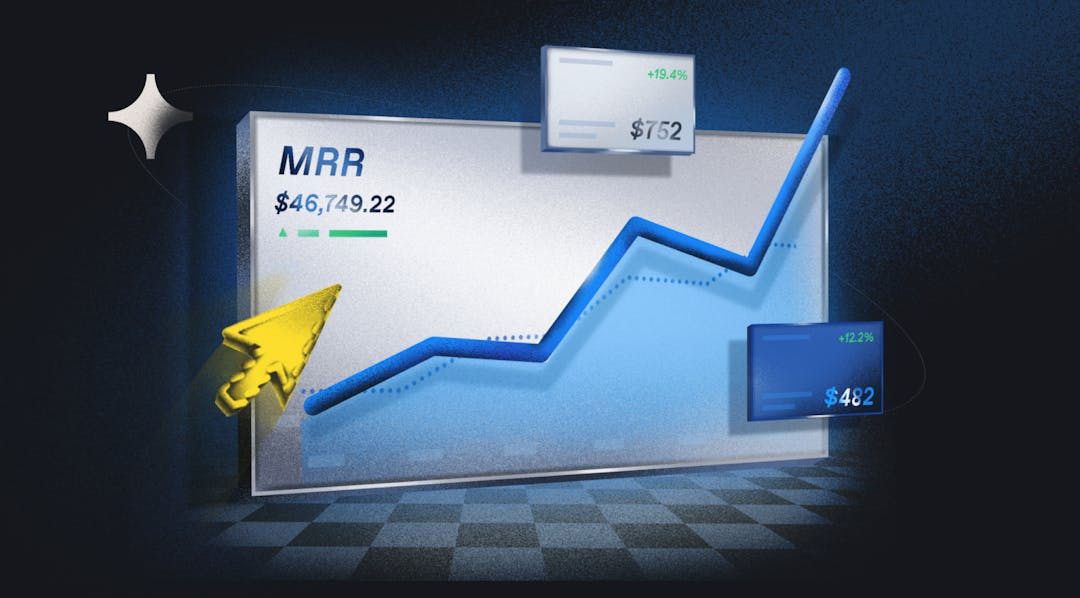Find out what subscription models are, the key benefits, how to implement subscription pricing to your business and how to monitor business performance.
Subscription pricing models continue to become a major part of modern software sales. The model has become one of the predominant business models for the software industry because it can be a powerful tool for growth. But in order to unlock that growth, subscription pricing must be implemented correctly.

What is a subscription business model?
A subscription business model is one in which customers are charged a recurring fee for access to a product instead of a one-time expense. This recurring fee is often paid monthly or yearly, and the customer is often given the choice of which frequency to purchase at. The subscription revenue model helps you capitalize on the compounding value of customer relationships; As long as your customers continually see the value your company provides for them, they'll continue to pay you for it.
6 main benefits of a subscription business model
We've talked about how the subscription business model has become a dominant model in the industry, and how much growth those who have chosen to employ it have experienced. But what exactly is it that drives the adoption of the model and the growth that it unlocks?
1. Predictable revenue stream
Once you've been operating long enough to collect data, the number of customers you gain and lose in a given time frame will be more predictable, making it easier to judge what your income will look like from one month to the next.
2. Recurring revenue
One of the big disadvantages of selling software for a one-time price is that you need to make massive improvements to the product in order to get people to buy the next version. This means holding back updates until a new version comes out. Recurring revenue solves that problem; customers get updates quicker and you are constantly getting paid.
3. Stronger & long-term customer relationships
With one-off pricing, customers pay you and the relationship largely fades into the background unless they need customer support or a new version is released. Because of the continuous update cycle of subscription-based software, your ability to respond to customer feedback in a timely manner and build the relationship is improved.
4. Lower customer retention spend
One-off software, while only a one-time fee, is a much larger expense than subscription services. When customers have already spent that money on the older version, they are reluctant to upgrade to a newer one. Greater marketing effort is required to convince them to upgrade.
5. Easier demand forecasting
With the right metrics, the same data that makes it easier to predict your revenue stream from month to month will make it easier to do demand forecasting.
6. Opportunities for upselling/cross-selling
subscription-based plans are more flexible. While you can offer different features for different prices on one-off software, moving between those isn't easy. A one-off purchase can't be downgraded the next month, for example. It's much more practical, then, to offer a wider range of options for subscription-based services. Because they can move between plans readily, customers are more likely to try out a higher tier.
6 subscription model examples
It doesn't matter if you're a SaaS company, streaming service, or a subscription box; the first step to better understanding the model is by looking at some successful subscription companies across industries.
1. Streaming services
Content streaming services are perhaps the most popular examples of subscription-based businesses. Companies like Netflix and Spotify are incredibly successful businesses thanks to their leveraging of the growth potential of subscriptions.
2. Monthly subscription boxes
Subscription boxes like Stitch Fix and Dollar Shave Club streamline the process of shopping for consumer goods, such as clothing and personal hygiene products. Their subscription pricing works because it monetizes convenience for their customers.
3. Software subscriptions
Paying for software as a subscriptions allows customers to get access to the latest and greatest software immediately, rather than having to wait for the next major release. Even big players such as Adobe and Microsoft have adopted the strategy.
4. Magazine subscriptions
These are perhaps the oldest subscription-based services. Now, the magazines may be delivered in print or via digital means, but the concept remains the same. Customers who want to stay informed are willing to pay a recurring fee to get access to the latest info.
5. Food services
Meal-kit services, like Blue Apron and HelloFresh, also use a convenience-based subscription model. They're similar to the subscription boxes, but add value by providing access to niche products like selections catered toward different types of diets.
6. Health & wellness
This category spans many types of subscriptions. BeachBody, once famous for their DVD fitness videos, has launched a subscription-based streaming service. Whoop provides a fitness band for a monthly subscription fee. This works well because it lowers the initial investment for those who may not be sure they'll stick with it.
6 tips for subscription businesses
Subscription pricing is a powerful and versatile business model. But implementing it correctly requires the right tools and strategy. With our comprehensive knowledge of the subscription economy, we've put together six tried-and-true tips to use while building your own subscription business.
1. Calculate willingness to pay
A big mistake made by subscription-based businesses is charging more, or less, than customers are willing to pay. Doing due diligence about the market you're in will help you to optimize the price you charge for your products, and may even help you split your product into different subscription tiers.
2. Determine your goals early
What exactly do you want to accomplish through subscription? More revenue, faster growth? Defining these goals early on helps ensure you're building the best pricing strategy possible for your specific goals. When your recurring revenue is tied directly to the monthly or annual fees, long-term strategic thinking is important.
3. Boost acquisition with a better experience
The more customers you have, the more revenue you'll get. This simple reality is why signing up for your subscription service needs to be as easy as possible. A great customer experience will improve your acquisition numbers over time. When combined with a great overall onboarding journey, you'll also find a higher average willingness to pay.
4. Streamline the billing process
Don't lose out on revenue because your subscription billing system isn't reliable. Most modern software services have a number of complex processes involved in account billing and you need to nail all of them. If your billing process is too complex, your customer won't stick around long.
5. Develop strong customer relationships
Without strong and lasting customer relationships, you'll be constantly losing customers and trying to replace them. Customers who aren't happy, or who aren't reminded of the value your service provides on a regular basis, won't stick around. Focus on retaining customers for as long as possible by fostering these relationships.
6. Plan for growth before it happens
A good subscription business model helps you scale. This steady stream of predictable income, evaluated against churn rates and operating costs, ensures the growth you project is sustainable. Without this knowledge, however, your growing customer base can quickly overload your infrastructure.
Nailing your subscription pricing models
Now that you understand the strategies used in building a subscription-based business model, it's time to take it a step further and look into how to manage that model once it's up and running.
Rely on a freemium subscription model to acquire new customers
Freemium is great for bringing in customers. But for it to work, you need to understand what it is and isn't. Freemium pricing is an acquisition tool, not a model for consistent revenue. It's designed to significantly widen the top of your funnel and give you more time to nurture new customer relationships. This boost to acquisition is what drives MRR for companies like Slack and Dropbox, and helps to offset CAC in the long term.
By allowing customers to experience the value you provide through a freemium plan, you're making it easier to offer them upsells, add-ons, or premium pricing to increase and build on that value.
Use a tiered subscription model to give your customers a choice
A one-size-fits-all price doesn't work for subscription businesses. Subscription pricing makes it easy for customers to experiment and find the right plan for them. Give customers the choice of a specific pricing tier based on their individual needs and let them try them out. This helps you appeal to more buyers, which can drive more widespread customer acquisition.
Our research shows that companies who adopt structured pricing tiers consistently have a higher ARPU than those who don't. By using relative feature preference and willingness to pay data, you'll be able to appeal to a number of different customer types.
Charge your customers fairly with a usage-based subscription model
A usage-based subscription only charges customers for the resources they've used. While this isn't practical for all subscription companies, it offers customers the best value for those it works with. When customers receive a 1:1 return on what they are paying, they're more likely to stick around.
Some companies have a base price that includes a certain amount of usage, and a usage-based fee for customers who go over that amount. For example, an email list provider may allow a certain number of emails to be sent for a set fee, and then charge an additional fee for every 1,000 emails over that amount. If you go this route, make sure you aren't giving them so much in the base price that they end up feeling as though they're paying for something they aren't using.
Change pricing often as you refine your product
Subscription-based pricing models are highly adaptable; it's easy to test and re-evaluate your prices on an ongoing basis. Through direct customer and market research, you'll know when conditions are favorable for a change and can proceed with the knowledge that you've set the company up for success.
You should automatically re-evaluate your pricing every six months. Analysis every other quarter will ensure that you're always thinking about what's best for your business as well as your customers. You should also re-evaluate pricing whenever there's a major change in features.
Key subscription business model metrics to track
Once you've got your basic strategy down, it's time to start tracking the important KPIs that will help you measure your progress and determine the health of your company. For subscription businesses, some of the most valuable KPIs to track include:
- Monthly recurring revenue (MRR) - This is simply the average amount of money that your company brings in per month. Ideally, this number will grow over time.
- Annual recurring revenue (ARR) - Annual recurring revenue is just like monthly recurring revenue, except it's calculated per year instead of per month.
- Average revenue per user (ARPU) - Like the previous two metrics, this one is based over a specific time period. Whether it's monthly or annually, the calculation is the same; simply divide the amount of revenue made during that time period by the number of paying customers for the period.
- Customer lifetime value (CLV) - This is the amount the customer spends with you from the time they sign up to the time they leave. Combined with CAC, below, it's a powerful metric.
- Customer acquisition cost (CAC) - This refers to the cost of marketing and other expenses required to get a single customer. If your CAC is higher than your CLV, you're losing money.
How Paddle products ProfitWell Metrics and Price Intelligently facilitate your SaaS subscription model strategy
Thanks to our many years of experience in the subscription pricing industry, Paddle has a collection of tools and services to help companies just like yours make the jump to subscription pricing in the most profitable way possible.
ProfitWell Metrics
We've seen some great metrics for tracking the success of your subscription business. But you can't track those KPIs without the proper tools. ProfitWell Metrics is a free analytics tool designed specifically for subscription businesses. Metrics will make it easy to track the metrics above, and many more, as you work to grow your company.
Price Intelligently
Finding the best price for your subscription service, and the best tiers to split it into is difficult. Willingness to pay calculations requires a healthy dose of industry expertise, along with a fair amount of very specific data. Price Intelligently helps you find the right pricing by using our years of experience to collect and analyze the right data on your behalf.
Subscription business model FAQs
Why do subscription business models work?
Customers and businesses alike prefer subscription models because they provide a great balance of price versus value. Customers get the convenience of automatically having the product when they need it, or getting immediate access to new features. Businesses get a more stable source of income.
What are the disadvantages of the subscription business model?
Because subscription businesses often rely on making their money in the long-term as opposed to in one lump sum, they require customers to stick around for a while. Businesses that aren't careful about controlling churn can find themselves spending more on CAC than they are getting back from existing customers.
What is the difference between a membership vs subscription business model?
These terms are often used interchangeably, and several different people may all mean something different when saying them. In general, memberships give access to physical locations, such as a gym or a golf club. Whereas subscriptions give access to the product or service being subscribed to.




